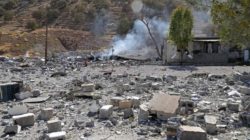BAGHDAD – The remains of the Al-Nouri Mosque in Mosul, northern Iraq, are starting to come back to life, surrounded by structures that were reduced to rubble years ago. Daesh damaged the landmark structure, as well as many others in Mosul’s famed Old City, during the fighting that raged here in December 2017.
The UNESCO-led “Revive the Spirit of Mosul” initiative, which is rebuilding the city’s devastated heritage landmarks, is giving Iraqis and tourists alike optimism that the city’s rich past will once again be able to shine.
Al-Nouri was built in the 12th century and is famous for its leaning minaret, which earned it the moniker “the hunchback” or “Al-Hadba” in Arabic. Daesh leader Abu Bakr Al-Baghdadi appeared at the mosque pulpit in July 2014 and declared Iraq and Syria the terrorist group’s “caliphate.”
Three years later, Daesh toppled the mosque’s beloved minaret, an act described as “an official confession of defeat” by Iraq’s prime minister at the time.
Daesh used the structure’s destruction as propaganda, blaming it on a US-led global coalition bombing. In 2017, Alberto Fernandez, then-vice president of the Middle East Media Research Institute, told USA Today, “Jihadist followers are exploiting it to criticize the West and Americans.”
In 2018, a year after Daesh was driven out of the city, the UAE pledged $50.4 million to fund Mosul’s rehabilitation, an amount described by UNESCO Director General Audrey Azoulay as “the greatest and (most) unprecedented collaboration to rehabilitate cultural assets in Iraq ever.”
The restoration project is one of numerous initiatives established in recent years by local, regional, and international organizations to repair Iraq’s many great but damaged ancient landmarks.
The project “Revive the Spirit of Mosul” will focus on documenting and clearing the site, developing plans for reconstruction, and eventually, four years of restoration and faithful reconstruction of the Al-Nouri Mosque minaret and neighboring buildings. There are also proposals to restore the city’s historic gardens as well as construct a memorial and site museum.
Iraq, long known as the cradle of civilization, is home to over 10,000 cultural heritage sites, ranging from the 5,500-year-old Sumerian cities (where evidence of the world’s earliest writings is preserved) to archaeological remains of the Akkadian, Babylonian, Assyrian, Parthian, and Abbasid cultures.
“These ages, particularly the Abbasid, which made significant attempts to preserve and expand old knowledge from earlier cultures and empires, have affected our world today,” Lanah Haddad, regional director for Tarii, Iraq’s Academic Research Institute, told Arab News.
“The image of Iraq as a cradle of civilization does not end with these periods; it continues with its ups and downs until the present.”









